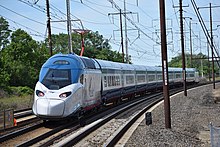
Amtrak's 25 Hz traction power system is a traction power network for the southern portion of the Northeast Corridor (NEC), the Keystone Corridor, and several branch lines between New York City and Washington D.C. The system was constructed by the Pennsylvania Railroad between 1915 and 1938 before the North American power transmission grid was fully established. This is the reason the system uses 25 Hz, as opposed to 60 Hz, which is the standard frequency for power transmission in North America. The system is also known as the Southend Electrification, in contrast to Amtrak's 60 Hz traction power system that runs between Boston and New Haven, which is known as the Northend Electrification system.
In 1976, Amtrak inherited the system from Penn Central, the successor to the Pennsylvania Railroad, along with the rest of the NEC infrastructure.
Only about half of the system's electrical capacity is used by Amtrak; the remainder is sold to the regional railroads that operate their trains along the corridor, including NJ Transit, SEPTA and MARC.
The system powers 226.6 miles (364.7 km) of the NEC between New York City[a] and Washington, D.C.,[b] the entire 104-mile (167 km) Keystone Corridor, a portion of NJ Transit's North Jersey Coast Line (between the NEC and Matawan), along with the entirety of SEPTA's Airport, Chestnut Hill West, Cynwyd, and Media/Wawa lines.
Cite error: There are <ref group=lower-alpha> tags or {{efn}} templates on this page, but the references will not show without a {{reflist|group=lower-alpha}} template or {{notelist}} template (see the help page).
